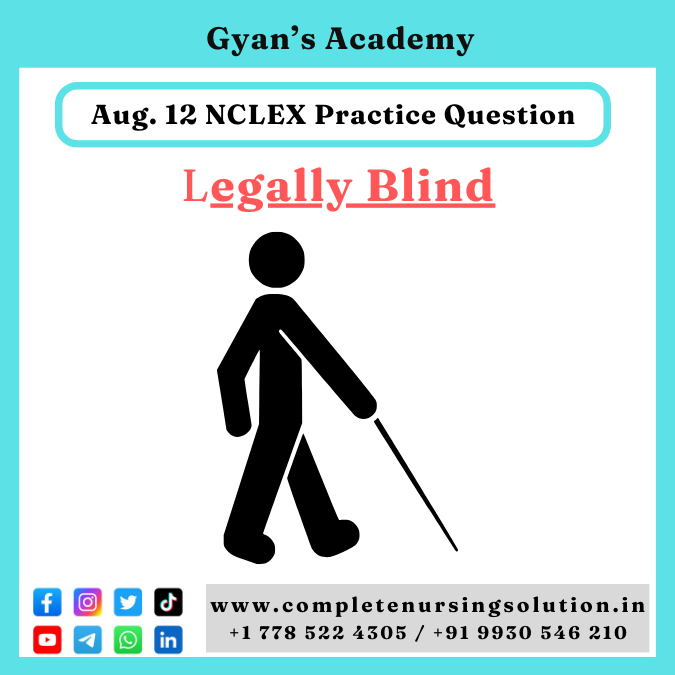On the first postoperative day, the nurse assists the client with
- Ambulation to evaluate alertness,
- Pain level,
- Signs of orthostatic hypotension,
- Problems with gait or mobility, and
- Ability to ambulate safely.
The nurse also considers pre-existing limitations to ambulation such as the use of assistive aids (eg, sighted guides, canes, guide dogs). Clients who used any ambulatory assistive aids before surgery require postoperative evaluation prior to ambulatory independence. When walking with a client who is legally blind, the nurse uses the sighted-guide technique by walking slightly ahead of the client with the client holding the nurse's elbow. The nurse should describe the environment while ambulating the client.
(Option 1) The service dog may be brought to the hospital to assist in ambulation once the nurse has determined the client can ambulate safely.
(Option 2) After evaluation by the nurse, the client may be allowed to use a cane to ambulate around the nursing unit.
(Option 3) Instructing the unlicensed assistive personnel to ambulate the client is an inappropriate assignment for a client who is 1 day postoperative and legally blind. Nursing assessment is required to determine if the client is able to ambulate safely.
Educational objective: When ambulating a client who is legally blind, the nurse uses the sighted-guide technique by walking slightly ahead with the client holding the nurse's elbow.
On the first postoperative day, the nurse assists the client with
- Ambulation to evaluate alertness,
- Pain level,
- Signs of orthostatic hypotension,
- Problems with gait or mobility, and
- Ability to ambulate safely.
The nurse also considers pre-existing limitations to ambulation such as the use of assistive aids (eg, sighted guides, canes, guide dogs). Clients who used any ambulatory assistive aids before surgery require postoperative evaluation prior to ambulatory independence. When walking with a client who is legally blind, the nurse uses the sighted-guide technique by walking slightly ahead of the client with the client holding the nurse's elbow. The nurse should describe the environment while ambulating the client.
(Option 1) The service dog may be brought to the hospital to assist in ambulation once the nurse has determined the client can ambulate safely.
(Option 2) After evaluation by the nurse, the client may be allowed to use a cane to ambulate around the nursing unit.
(Option 3) Instructing the unlicensed assistive personnel to ambulate the client is an inappropriate assignment for a client who is 1 day postoperative and legally blind. Nursing assessment is required to determine if the client is able to ambulate safely.
Educational objective: When ambulating a client who is legally blind, the nurse uses the sighted-guide technique by walking slightly ahead with the client holding the nurse's elbow.




Thank you for your sharing. I am worried that I lack creative ideas. It is your article that makes me full of hope. Thank you. But, I have a question, can you help me?
The depth in this serving is exceptional.
More peace pieces like this would create the интернет better.
The thoroughness in this piece is noteworthy.
I don’t think the title of your article matches the content lol. Just kidding, mainly because I had some doubts after reading the article. https://www.binance.com/en/register?ref=JHQQKNKN
Concierge-quality cleaning, perfect for our high-end finishes. Recommending to luxury properties. Luxury living perfected.
Dry Cleaning in New York city by Sparkly Maid NYC
You made some decent points there. I looked on the internet for the subject and found most individuals will go along with with your website.
Thanx for the effort, keep up the good work Great work, I am going to start a small Blog Engine course work using your site I hope you enjoy blogging with the popular BlogEngine.net.Thethoughts you express are really awesome. Hope you will right some more posts.
It is actually a nice and useful piece of info. I’m happy that you simply shared this useful info with us. Please stay us up to date like this. Thank you for sharing.
Aw, this was a really nice post. In idea I would like to put in writing like this additionally – taking time and precise effort to make an excellent article… but what can I say… I procrastinate alot and under no circumstances seem to get something done.
Throughout the great design of things you get a B- for effort and hard work. Where you actually lost everybody ended up being in all the particulars. You know, people say, the devil is in the details… And it couldn’t be more accurate right here. Having said that, let me reveal to you just what exactly did give good results. Your text can be really engaging and that is probably why I am taking an effort in order to comment. I do not really make it a regular habit of doing that. Next, whilst I can easily notice a jumps in reason you make, I am not really sure of just how you appear to connect your details which in turn help to make your conclusion. For the moment I will subscribe to your issue but wish in the foreseeable future you actually connect your dots better.
Great post, I think people should learn a lot from this website its rattling user pleasant.
Can I just say what a relief to find someone who actually knows what theyre talking about on the internet. You definitely know how to bring an issue to light and make it important. More people need to read this and understand this side of the story. I cant believe youre not more popular because you definitely have the gift.